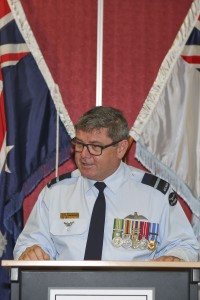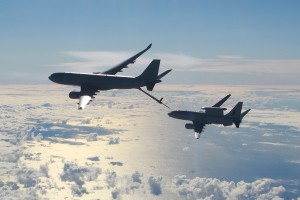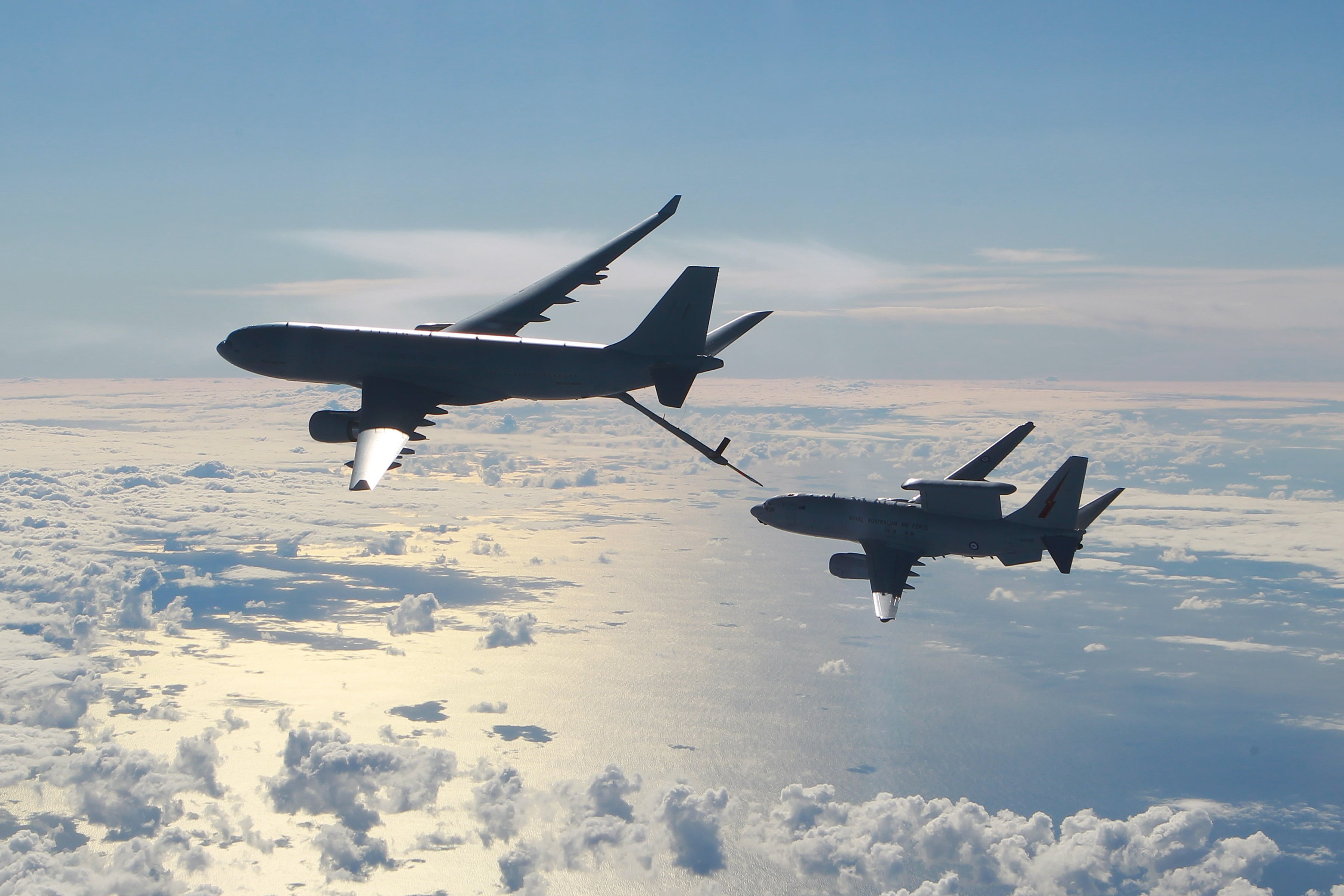2015-10-03 By Robbin Laird
My last visit to a Royal Australian Air Force base during my visit to Australia in August 2015 was to Williamtown Air Base, which is the home for the Surveillance and Response Group (SRG) as well as the key fighter squadrons.
Prior to a round table with the 4 Wings in the SRG, I had a chance to discuss the role of the SRG and the way ahead for Plan Jericho as viewed by the Commander of SRG, Air Commodore “Shorty” Westwood.
For Air Commodore Westwood, Plan Jericho was a leadership vision about innovation, which was coming at the right time.
The RAAF has undergone a significant re-capitalization effort, but to get best combat effect from the force, the key was to shape effective integration, which would transform the effects, which the force could deliver.
On 25 June 2015 members of No 52 Airborne Electronics Analyst Course graduated from the 12 month long course conducted at No 292 Squadron.

Air Commodore Westwood: “I’m sure you’ve noticed there’s a real degree of excitement in the Air Force about Jericho.
It’s come on the back of a very successful capital improvement program over 20 years.
The Air Force that we see today is fundamentally a really good mid-sized air force.
When you pull those platforms together, the next logical step is to ask where is the next bang for the buck?
It’s not buying necessarily more platforms; it’s getting more out of them.
There’s a general feeling around the Air Force that the Jericho Plan just arrived at the right time.
And we are taking the Jericho mentality into the joint and coalition environment.
We are not just looking to reshape the RAAF; it is about working with our joint and coalition partners and shaping more effective forces.
We’re looking for Jericho-like activities and trusted relationships throughout the joint and coalition environment.”
He characterized SRG as a “pre-Jericho” force in the sense that the various ISR and C2 assets within the SRG were focused on collaborative ISR and C2 to provide both protection for Australia and to enable the expeditionary force to operate more effectively.
The force consists of four wings, each of which plays a particular role within the overall ISR/C2 effort.
Surveillance and Response Group has over 2100 personnel spread across Australia working in the following areas:
- No 41 Wing (Air Defence / Air Battle Management)
- No 42 Wing (Airborne Early Warning and Control)
- No 44 Wing (Joint Battlefield Airspace Control)
- No 92 Wing (Maritime Operations).
The foundation force is the over the horizon ground based radar, which provides the core information to assess threats and challenges in the area surrounding Australia. Space-based ISR is now integrated as well with the ground based radar data. This is completed by truck-based radar that can be moved to deal with a particular challenge.
It is combined with the P-3 and now the P-8 (coming next year) to provide effective maritime surveillance data and positional targeting capabilities.
The Wedgetail can operate over the areas of interest and provide the air-sea-land C2 most effective for the joint force.

And the Air Traffic Control system provides for an integrated military and civilian air space, within which UAVs such as the newly acquired Heron can operate throughout Australian airspace as well. 44 Wing provides a significant capability which is captured by the concept of Joint Battlefield Aerospace Control or JBAC.
The 44 Wing concept of air traffic control encompasses the tactical role of the JBACs as well.
Air Commodore Westwood: “The goal is seamless integration which is always a work in progress, but that is why I think we are key part of the shaping of an effective Jericho policy.”
Australia has a large front yard and backyard.
The SRG’s primary task is to provide information about the dynamic environment around Australia to enable the defense force to provide for effective means to operate in the defense of Australia.
Air Commodore Westwood: “When you focus on all of Australia and the approaches to Australia, you are talking about a very large front and backyard.
And we are working US and allied forces in providing for defense of the region, which expands the challenge of shaping collaborative ISR/C2 capability information and enabling the force.
That is our challenge and our task.
We have multiple tools at our disposal.
And every part of that ISR family brings something different.
Every part of the ISR puzzle has strengths and it has weaknesses.
The secret in managing your front and backyard is to be persistent.
You need to know what happens in your, in your front and back yards on a timely, accurate and persistent basis.”
Editor’s Note: The Royal Australian Air Force’s Surveillance and Response Group is responsible for:
- All of the Air Forces traditional air surveillance assets
- Maritime warfare
- Aerospace, surveillance and battle space management
- Developing intelligence, surveillance and reconnaissance (ISR) and electronic warfare (EW) capabilities.
Surveillance and Response Group has over 2100 personnel spread across Australia working in the following areas:
- No 41 Wing (Air Defence / Air Battle Management)
- No 42 Wing (Airborne Early Warning and Control)
- No 44 Wing (Joint Battlefield Airspace Control)
- No 92 Wing (Maritime Operations).
Surveillance and Response Group (SRG) was formed on 30 March 2004 by merging the former Surveillance and Control and Maritime Patrol Groups. Its motto is ‘Foremost Sentinel’, which encapsulates the group’s contribution as the early warning and response capability of the Australian Defence Force.
Headquarters Surveillance and Response Group is at RAAF Base Williamtown, NSW. Its personnel are responsible for personnel management, capability management and development, technical capability and business management.
No 41 Wing (41WG) based at RAAF Base Williamtown, commands all of the Air Defence operational and training units.
Spanning across Australia, these units include 3 Control and Reporting Unit (3CRU) and Surveillance and Control Training Unit (SACTU) located in Williamtown; 114 Mobile Control and Reporting Unit (114 MCRU) in Darwin and 1 Radar and Surveillance Unit (1 RSU) in Adelaide. SACTU provides the training for Air Combat Officers and Air Surveillance Operators to enable them to perform effective air battle management and surveillance operations.
41 Wing headquarters is chiefly responsible for tasking of its subordinate units in order to provide continuous wide-area surveillance, airspace control and execution of air battle management operations.
No 42 Wing (42WG) reformed on 1 January 2006 and is located at RAAF Base Williamtown. The Wing delivers the ‘Wedgetail’ Airborne Early Warning and Control (AEW&C) capability for the Air Force.
This capability incorporates independent air and support operations in the maritime and land environments, with 2SQN supporting the aircraft and project at Williamtown. The AEW&C aircraft represents an entirely new capability for the ADF, providing a platform that will gather information from a wide variety of sources, analyse it and distribute it to all friendly air and surface assets.

AEW&C will control the tactical battle space, providing direction for fighter aircraft, surface combatants and land based elements, as well as supporting aircraft such as tankers and intelligence platforms.
No 44 Wing (44WG), headquartered at RAAF Base Williamtown, commands all of the Air Traffic Control (ATC) detachments of which there are eleven across Australia. 44WG also commands the ATC Technical Ground Electronic Services (GES) workforce.
44WG through its detachments is responsible for the delivery of fixed and remote air traffic control services to Army, Navy and Air Force and also for the provision of tactical control of forward airfields, battlefield aviation and other airspace activity, both within Australia and for operational deployments.
44WG personnel have been actively involved in a number of recent operations including Sudan, East Timor, Iraq/Middle East, Solomon Islands and Indonesia. Their roles have ranged from active operational duties to training, peacekeeping and humanitarian missions.
Headquartered at RAAF Base Edinburgh, No 92 Wing (92WG) has long been established as the first Maritime Wing in the history of the Royal Australian Air Force. 92 WG commands two flying squadrons, Nos 10 and 11 Squadrons, a training unit, No 292 Squadron; an operational detachment, 92WG Detachment A at Butterworth, Malaysia; and a number of operational support and development elements.
Operating AP-3C Orion aircraft, 92WG’s combat roles include anti submarine and anti surface surveillance maritime warfare for which the aircraft are equipped with torpedoes and Harpoon anti shipping missiles.
The Wing is also responsible for conducting long range intelligence, surveillance and reconnaissance missions in support of Australia’s national interests worldwide. 92 WG is also responsible for search and survivor supply missions throughout Australia’s region of responsibility.
The P-8 is coming to the RAAF as well and the RAAF website described the aircraft and its role as follows:
The P-8A Poseidon will provide Air Force with an advanced maritime intelligence, surveillance, reconnaissance and response aircraft.
The P-8A Poseidon uses advanced sensors and mission systems, including an advanced multi-role radar, high definition cameras, and an acoustic system with four times the processing capacity of Air Force’s current AP-3C Orions.
Together with the MQ-4C Triton Unmanned Aerial Vehicles, the P-8A aircraft will replace the AP-3C Orions.
Planned for RAAF Base Edinburgh, the P-8A has an extensive communications suite that includes radios and data links across VHF, UHF, HF and SATCOM spectrums. An internal fuel capacity of almost 34 tonnes, gives the P-8A the ability to remain on station conducting low level anti-submarine warfare missions at a distance of greater than 2,000 kilometres from base.
The P-8A will be compatible for air-to-air refuelling with the KC-30A MRTT.
Air Force will acquire eight P-8As, with the option for a further four subject to the outcomes of the Defence White Paper review.
The first aircraft will be delivered in 2017, with all eight aircraft fully operational by 2021.
The acquisition of the eight P-8A aircraft will cost approximately $4 billion, including support facilities.
The P-8A is built from the ground up as a military aircraft. It is based on the proven commercial designs of Boeing’s 737-800 fuselage, but is substantially structurally modified to include a bomb bay, under wing and under fuselage hard points for weapons, as well as increased strengthening to allow for continued low level (down to 200 ft) operations and 60° angle of bank turns.
Initial Operational Capability (IOC) for the P-8A is scheduled for the period 2017 – 2020.
And the MQ-4C Triton aircraft is described on the RAAF website as follows:
The MQ-4C Triton Unmanned Aircraft System (UAS), is a high altitude, long endurance (HALE) aircraft that will be used for maritime patrol and other surveillance roles.
Supporting missions up to 24 hours, the MQ-4C Triton is equipped with a sensor suite that provides a 360-degree view of its surroundings, for over 2,000 nautical miles.
Up to seven MQ-4C Tritons will be based at RAAF Base Edinburgh (SA) and will operate from the runway alongside the P-8A Poseidon when it enters RAAF service.
The MQ-4C Triton will operate alongside the P-8A to replace the ageing AP-3C Orion capability. The endurance of the MQ-4C Triton means it can stay airborne for longer than a traditional aircraft where the pilot is in the aircraft.
Like other Air Force aircraft, the Triton will be flown by a qualified RAAF pilots, experienced in complex airspace. However the Triton will be flown a ground station where pilots are supported by a co-pilot while the information gathered is analysed and disseminated by up to operational staff.
Operational staff may include aircrew, intelligence, operations and administration officers, engineers and logisticians, depending on the training or mission requirements.
Whilst building on elements of the Global Hawk UAS, the Triton incorporates reinforcements to the airframe and wing, along with de-icing and lightning protection systems. These capabilities allow the aircraft to descend through cloud layers to gain a closer view of ships and other targets at sea when needed and will complement theP-8A Poseidon.
The Triton platform has been under development by the United States Navy since 2008.
According to a May 29, 2015 article on the RAAF website:
Airservices Australia and the Royal Australian Air Force (RAAF) entered into a Memorandum of Agreement (MoA) today for the operation of the Heron remotely piloted Unmanned Aircraft System (UAS) in Australian civil airspace.
Commander of Surveillance and Response Group Air Commodore Chris Westwood and Airservices Australia’s Executive General Manager Air Traffic Control Greg Hood signed the MoA at a ceremony in Canberra.
Air Commodore Chris Westwood said the MoA formalises the partnership between Airservices Australia and Air Force and enhances Australia’s position on UAS.
“The purpose of the MoA is to set out procedures for Airservices Australia and Air Force to work within, and allows the Heron to be safely flown in civil airspace without any significant impact on civil air traffic,” Air Commodore Westwood said.
“The MoA aids both Airservices and Air Force by facilitating the initial operation and integration of remotely piloted aircraft into civil airspace, based on Air Force’s mature and thorough airworthiness and aviation safety system.”
The Civil Aviation Safety Authority, the regulator of all Australian airspace, will also work with Airservices and Air Force to monitor the arrangements from a civil aviation safety perspective.
Airservices Australia Executive General Manager Greg Hood said that the agreement further reinforces the close working relationship between Airservices and the Royal Australian Air Force and ensures that UAS are operated safely in civilian airspace.
“This MoA is recognition of the changing way that airspace is being used to embrace new technologies,” Mr Hood said.
“We look forward to continuing to work collaboratively with Defence on the use of this type of technology safely in Australian airspace.”
The Heron is planned to fly in civilian airspace from Rockhampton Airport in late June, as part of Exercise Talisman Sabre 2015. This will be the first time the aircraft has flown outside of restricted military airspace in Australia.
Air Force currently operates two Heron aircraft from RAAF Base Woomera in South Australia, as part of a plan to ensure that Australia remains at the forefront of advancing aviation technology and that Air Force pilots maintain the skills to operate UAS until the introduction of the MQ-4C Triton.


